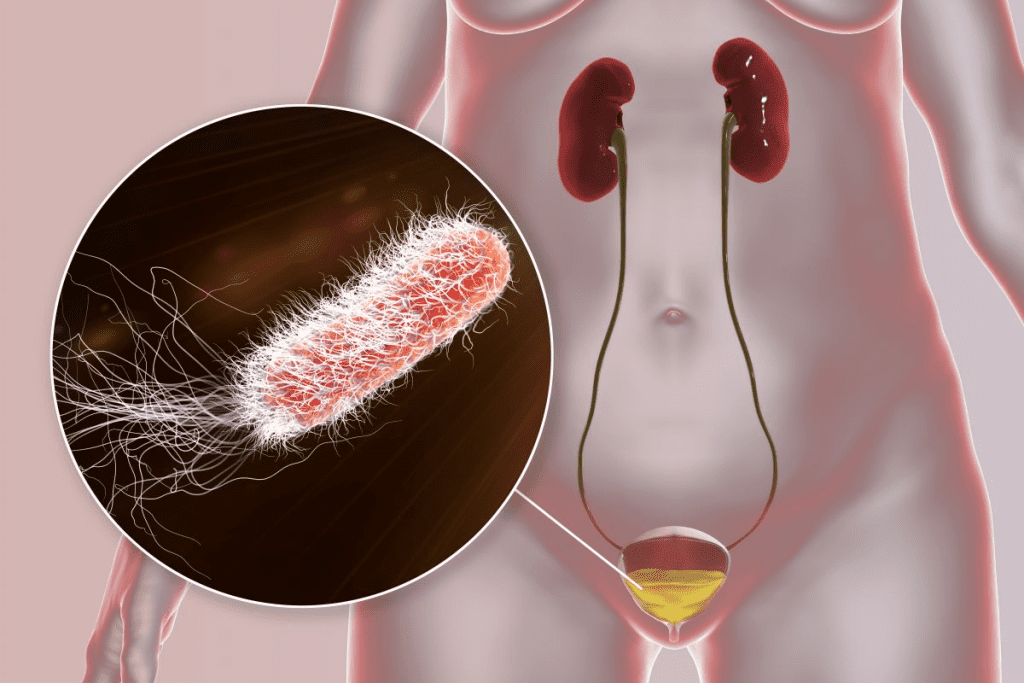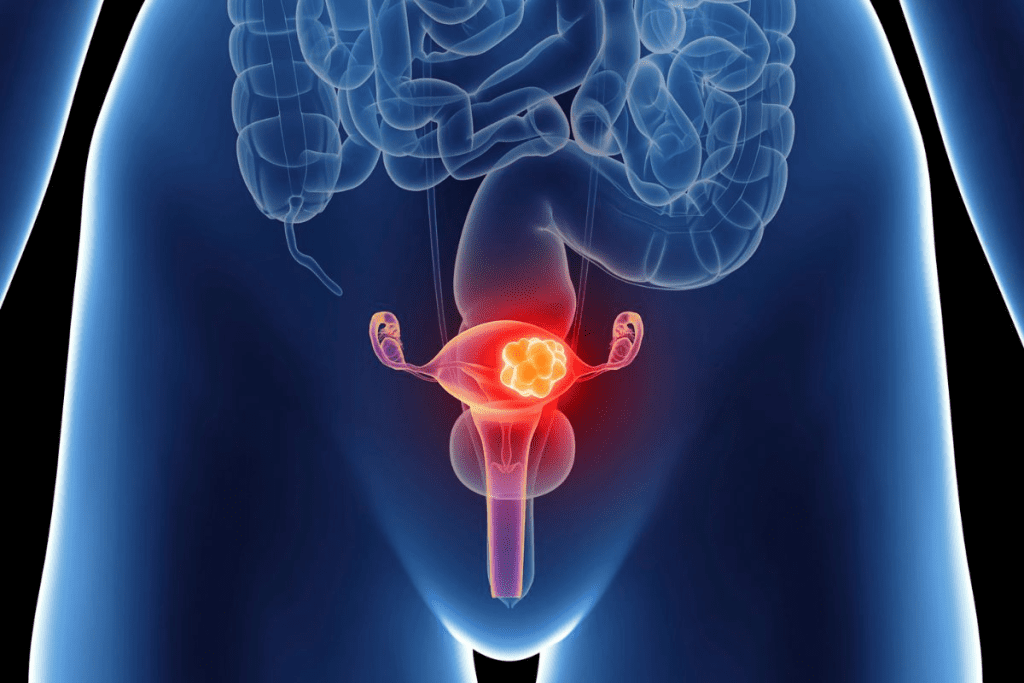Last Updated on November 25, 2025 by
It’s important to know the signs of a tumor in the bladder to get help early. We’ll show you the common symptoms to watch out for.
Blood in the urine, or hematuria, is a key sign. About 80-90% of people with this issue see it. It might look like orange, pink, or dark red urine.

Other signs include needing to pee a lot and feeling pain when you do. If you notice these, see a doctor right away.What are the bladder cancer symptoms of a tumor? Learn the dangerous, crucial warning signs, including blood in urine.
Bladder tumors are abnormal growths in the bladder’s lining. Knowing about them is key for treatment. We’ll look at the basics, including types and how common they are.
A bladder tumor is an abnormal growth in the bladder’s lining. These can be benign or malignant. Malignant tumors are cancerous and can spread to other parts of the body.
The most common bladder cancer starts in urothelial carcinoma or transitional cell carcinoma cells.

There are several types of bladder cancer, each named after the cell type where it starts. The main types include:
Bladder cancer is a big health issue in the United States. In 2025, there will be about 84,870 new cases and 17,420 deaths from it. These numbers highlight the need for awareness and early detection.
Understanding bladder cancer’s impact and factors is vital. This knowledge helps us tackle this disease more effectively.
It’s important for patients to know the symptoms of bladder cancer. This knowledge helps them get medical help quickly. Bladder cancer symptoms can really affect a person’s life.
The most common sign of bladder cancer is hematuria, or blood in the urine. This can be seen with the naked eye or found through a test. Finding blood in the urine is a big warning sign.

Blood in the urine can have many causes. But when it’s due to bladder cancer, it keeps happening. It often comes with other urinary problems.
Bladder cancer can also change how you urinate. You might need to go more often, feel a sudden need to go, or have trouble starting. These changes can really mess up your day.
Some people feel like they need to go even when their bladder isn’t full. This can be really upsetting. It’s a big reason to see a doctor.
Pain or burning while urinating is a symptom that shouldn’t be ignored. This discomfort can be mild or very bad. It often means there’s something wrong with the urinary tract.
In bladder cancer, this pain can mean a tumor is affecting the bladder. It’s important to remember that these symptoms can also mean other, less serious problems. But, if you’re experiencing any of these, you should see a doctor to find out why.
It’s important to know the early signs of bladder tumors to get medical help quickly. These symptoms can be subtle or mistaken for other issues.
Frequent urination is a key sign of bladder tumors. As the tumor grows, it can block urine flow. This leads to needing to go to the bathroom more often. If you’re urinating more than usual, talk to your doctor.
The urgency to urinate without a full bladder is another symptom. It can be uncomfortable and disrupt your day. A bladder tumor can irritate the bladder walls, causing sudden urges to urinate.
Difficulty emptying the bladder is a serious symptom. As a tumor grows, it can block the urethra. This makes it hard to fully empty the bladder, leading to urinary tract infections.
The symptoms of bladder cancer can be intermittent. They may come and go, making diagnosis hard. Keeping a record of when symptoms occur can help your doctor.
Knowing these early signs can greatly impact bladder cancer diagnosis and treatment. If you’re experiencing these symptoms, see a healthcare professional.
As bladder cancer gets worse, it shows through severe symptoms. These signs mean the cancer has spread and might need quick medical help.
Lower back pain is a sign of advanced bladder cancer. The pain happens when the cancer reaches nearby tissues or organs. Lower back pain can make everyday tasks hard.
Advanced bladder cancer can make it hard to pee or reduce urine flow. This happens if the tumor blocks the urine path or damages bladder nerves.
Feet, ankles, or legs swelling is another sign. This swelling, or edema, comes from cancer in the lymph nodes. It messes with lymphatic drainage.
Persistent fatigue is common in advanced bladder cancer. Fighting the cancer and possible anemia or metabolic changes cause it. This exhaustion doesn’t get better with rest.
The symptoms of advanced bladder cancer can really affect a person’s life. Spotting these signs early is key for getting the right medical care.
If you notice symptoms that might be bladder cancer, it’s important to see a doctor. These symptoms can be like those of less serious issues. So, it’s key to get checked by a healthcare expert.
Some symptoms need quick medical help. These include:
If you notice any of these symptoms, seeing a doctor right away is important.
Before your doctor visit, prepare by:
Being ready can help make your doctor’s visit more effective.
Your doctor will ask several questions to help figure out what’s wrong, such as:
Answering these questions well can help your doctor understand your situation better.
Talking about possible cancer symptoms can be scary. But, getting medical help early is key for good treatment. If you’re worried about symptoms, don’t wait to schedule a visit with your healthcare provider.
Bladder cancer risk comes from lifestyle, environment, and genes. Knowing these factors helps us prevent bladder cancer. It can lower the chance of getting it.
Smoking and tobacco use are big risks for bladder cancer. Tobacco smoke’s chemicals get into the blood and harm the bladder. Quitting smoking greatly lowers this risk.
Key statistics on smoking and bladder cancer:
Age and gender play big roles in bladder cancer risk. Most cases happen in people over 55. Men get bladder cancer more often than women, but why isn’t clear.
Working with certain chemicals raises bladder cancer risk. Jobs in dye, paint, and industrial chemical use are risky. Workers should follow safety rules and get health checks.
Long-term bladder inflammation, from infections or other issues, ups bladder cancer risk. Treating these problems can lower this risk.
By tackling these risk factors, we can fight bladder cancer. This helps those affected and lowers its incidence.
Diagnosing bladder tumors is a detailed process. It helps doctors find out if cancer is present and how far it has spread. This is key to choosing the right treatment and improving patient care.
A physical exam is the first step in finding bladder tumors. A healthcare provider looks for any signs of tumors during this exam. While it can’t confirm cancer, it gives important first clues.
Urine tests are very important in diagnosing bladder tumors. They check for blood in the urine (hematuria) or cancer cells. These signs often point to bladder cancer. We use urine tests to spot any issues that need more checking.
Imaging tests like CT scans and ultrasound are key in finding bladder tumors. They let us see the bladder and nearby areas. This helps us find tumors, see how big they are, and where they are. These tests are vital for figuring out how serious the cancer is.
Cystoscopy and biopsy are the final steps in diagnosing bladder tumors. A flexible tube with a camera is used in cystoscopy to look inside the bladder. If something looks off, a biopsy is done to take tissue samples. These samples help confirm cancer and tell us what kind and how serious it is.
By using the results from physical exams, urine tests, imaging tests, and cystoscopy and biopsy, we can accurately find bladder tumors. Then, we can create a treatment plan that fits each patient’s needs.
Early detection and treatment of bladder cancer, like urothelial carcinoma, can greatly improve patient outcomes. Knowing the common symptoms, such as blood in urine and changes in urination, is key. This knowledge helps in getting medical help on time.
Understanding risks, like smoking and chemical exposure, helps in preventing the disease. If you notice any symptoms, seeing a doctor quickly is vital. Places like Liv Hospital offer top-notch care. They use the latest methods and team up with experts to help patients.
By spotting bladder cancer signs early and getting medical help, patients can get better care. This improves their life quality significantly.
Blood in the urine is a common sign of bladder cancer. It might look orange, pink, or dark red. You might also notice changes in how you urinate, pain, or a burning feeling.
Feeling like you need to urinate right away, even when your bladder isn’t full, is another symptom.
Blood in your urine could mean bladder cancer, but it’s not the only reason. It’s important to see a doctor to find out why it’s happening.
Yes, there are. Transitional cell carcinoma, or urothelial carcinoma, is the most common. It makes up about 90% of bladder cancers. There are also squamous cell carcinoma and adenocarcinoma.
Smoking and tobacco use increase your risk. So does age, gender, chemical exposure, and chronic bladder inflammation. Knowing these can help in early detection and prevention.
Doctors use physical exams, urine tests, and imaging to diagnose bladder cancer. They might also do a cystoscopy and biopsy. These tests help find and understand the cancer.
Symptoms of advanced bladder cancer include lower back pain and trouble urinating. You might also notice swelling in your feet and feel very tired all the time.
Yes, treating bladder cancer early can greatly improve your chances. If you’re experiencing symptoms or have risk factors, see a doctor right away.
At your doctor’s appointment, expect a physical exam and questions about your symptoms and health history. You might also have some tests done. It’s a good idea to write down your symptoms and any questions you have.
Avoid smoking and tobacco, limit chemical exposure, and manage bladder inflammation. Regular check-ups with your doctor can also help catch bladder cancer early.
Squamous epithelial cells are involved in some bladder cancers, like squamous cell carcinoma. Understanding their role helps in diagnosing and treating bladder cancer.
Genitourinary health is key to bladder cancer awareness. The genitourinary system includes the bladder and urinary tract. Keeping this system healthy and watching for changes can help in early detection.
Halaseh, S. A., Qandour, A. A., Amarneh, B., Suleiman, M., & AlDaghmin, A. (2022). A review of the etiology and epidemiology of bladder cancer. Cureus, 14(11), e31451. https://www.ncbi.nlm.nih.gov/pmc/articles/PMC9411696/
Subscribe to our e-newsletter to stay informed about the latest innovations in the world of health and exclusive offers!